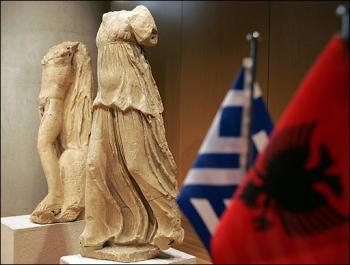 Active duty helicopter pilot Edward Earle Johnson was charged today with selling 80 antiques stolen from the Ma’adi Museum outside of Cairo.
Active duty helicopter pilot Edward Earle Johnson was charged today with selling 80 antiques stolen from the Ma’adi Museum outside of Cairo.
On September 29, 2002, 370 pre-dynastic artifacts ranging in date from 3,000 to 5,000 BC were stolen from the Ma’adi Museum. Chief Warrant Officer Johnson was deployed to Cairo from February to October of 2002.
In January of 2003, Johnson contacted a Texas art dealer offering to sell him a group of Egyptian antiquities that he claimed he had inherited from his grandfather who had acquired them in Egypt during the 30’s or 40’s. Bummer about him not having a sliver of documentation to support this provenance, of course, but why should that stop an art dealer from buying 90 5,000 year-old Egyptian artifacts for the bargain basement price of $20,000?
 Nor, heaven forfend, should the unsupported fiction inhibit Christie’s and a bunch of other galleries and collectors in New York, London, Zurich, etc. from purchasing some of the pieces from the dealer, a dealer later discovered by the feds to be an associate of Sotheby’s.
Nor, heaven forfend, should the unsupported fiction inhibit Christie’s and a bunch of other galleries and collectors in New York, London, Zurich, etc. from purchasing some of the pieces from the dealer, a dealer later discovered by the feds to be an associate of Sotheby’s.
As of January, the feds had recovered 80 of the 90 artifacts Johnson sold. Who knows where the other 260 antiquities stolen from the museum have ended up. Johnson hasn’t been charged with the theft, just with the sale, so that means the feds don’t have much in the way of prosecutable evidence on who actually did the stealing.
God, the antiquities trade is so dirty I could just spit.
 She was looted from Baghdad’s Iraq Museum in April of 2003, along with thousands more artifacts from the Cradle of Civilization, 10,000 of which have yet to be recovered.
She was looted from Baghdad’s Iraq Museum in April of 2003, along with thousands more artifacts from the Cradle of Civilization, 10,000 of which have yet to be recovered. 


